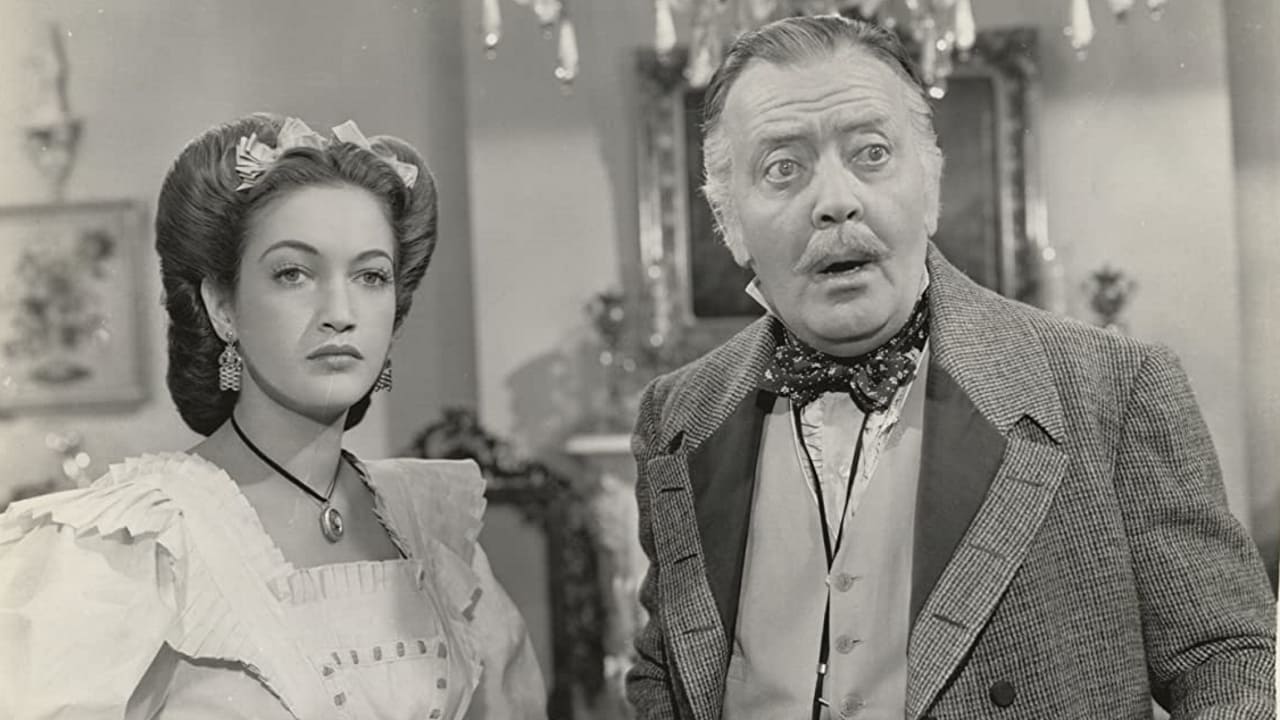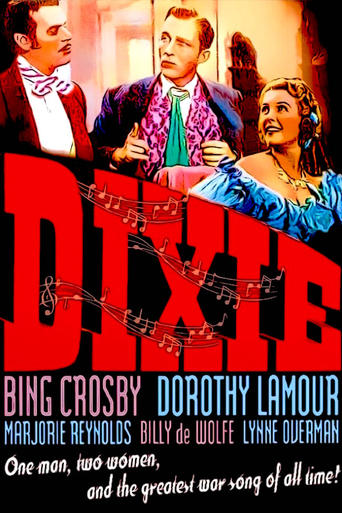



Excellent, smart action film.
A very feeble attempt at affirmatie action
In truth, there is barely enough story here to make a film.
View MoreAt first rather annoying in its heavy emphasis on reenactments, this movie ultimately proves fascinating, simply because the complicated, highly dramatic tale it tells still almost defies belief.
View MoreMy title is partially derived from one of the TV episodes of "Julia": a parody of Bing Crosby's hit song from "Holiday Inn", released the year before this film.....It is indeed ironic that "Dixie", as well as most of the other songs that have come to be associated with the antebellum South, were composed by two staunch Yankees: Dan Emmett and Stephan Foster, and mostly for Yankee minstrel shows. Unlike the story in this film, I could find no info that Emmett ever traveled into the South, and Foster made only one trip into the South, by steamboat to New Orleans, rather reminiscent of the scene early in this film when Crosby and a chorus of African Americans sing "Swing Low Sweet Chariot". This scene also reminds us of some of the scenes in Jerome Kerns' "Showboat". Emmett is also credited with being the inspiration behind the first full-fledged blackface minstrel show, in 1843. As in this film, this consisted of 4 men. However, in the film , the silly excuse for using blackface is to cover up their blackeyes from a brawl. Blackface routines had been around in the US since early colonial days, and in medieval Europe. Emmett was primarily a singer and instrument player, and had used blackface in his routines in circuses before this time. In the long interval between '43 and '58, he did not perform in minstrel shows, serving as a musician in various other capacities. Emmett composed "Dixie" in 1859, while a member of a NYC minstrel group. Initially a hit in the North, it was modified into a band piece and war song for the South, with many different lyrics. As in the finale, a performance in New Olreans did spark its popularity in the South. Unlike in the film, where he refuses to sell the copyright for $1., he sold it for $500. to a NYC firm. The fictitious bit in the film where Emmett is given $500.by his prospective father-in-law is perhaps derived from this bit of history.Although this is supposed to be a biographical treatment of Emmett, nearly all the details are totally fictitious, and nearly all the other songs were either new creations for this film, or 19th century songs composed by others! He had two wives, but they certainly weren't southern belles, as portrayed, one being from NYC and the other from Chicago, and they weren't competitors. The plot construction is a switcheroo romantic quadrangle: a very common plot formula in musicals of this era. If we substitute Fred Astaire for Billy De Wolfe and Vrginia Dale for Dorothy Lamour, we have essentially the same romantic melodrama as in "Holiday Inn" of the previous year. In both films, Crosby and Marjorie Reynolds end up a romantic couple in the finale. Dorothy is portrayed as a shameless hussy of a southern belle, whereas Marjorie is portrayed as true to Emmett, but offering to step aside for Dorothy when she discovers that Emmett planned to ditch her for Dorothy until he discovered that she had become partially paralyzed from polio, She surmised that he married her only out of pity. Incidentally,paralytic polio was a rather common and much feared disease when this film was made, exemplified by President Roosevelt. But, back in mid-19th century, it was a minor disease, and mostly of infants and young children, very rarely adults.This was the film debut for comedic character actor Billy De Wolfe, and he almost steals the show in the middle half, before mostly disappearing in the last portion.He essentially takes the place of Bob Hope, Fred Astaire, Martha Raye or Betty Hutton in Crosby's films of this era. He would help to enliven "Blue Skies": the second and less entertaining pairing of Crosby and Astaire.The film fails to convey the fact that his character's name: Mr. Bones, was a stock character in minstrels, originating from the use of 2 bones as a crude castanet. Mr. Bones was also one of the main characters in the extensive minstrel show in "Babes on Broadway".The 3 building fires served as a running gag, each supposedly started by Bing forgetting his lit pipe. Must have had some gasoline-soaked tobacco in that pipe! The first 2 fires served to end one phase of the film, while the last serves as an excuse to speed the tempo of "Dixie", and to destroy Marjorie's now unwanted letter of proposed divorce.This film is notable for the large amount of blackface entertainment. I have no problem with that. To me, it's no different from other forms of stage, film and circus clowning around, including all those 'white face' circus clowns. Historically, AAs often participated in such minstrel shows post Civil War. The NAACP is far too uptight about any public entertainment that portrays AAs in the stock negative characterizations of minstrel shows, early films, and the 'Amos and Andy' TV show, which was one of my favorite shows as a kid. Unfortunately, TV executives overreacted to criticism of the characterizations in this show and cancelled all shows dominated by AAs, including Nat Cole's show.Finally, in the late '60s, "Julia" was tried. It was the first sitcom to present AAs as legitimate middle class Americans, but was criticized for presenting an atypical AA characterization. The characters were said to be essentially 'whites with black faces' and Ms. Carroll was a light-skinned AA, thus a compromise AA.See this film on You Tube, in 9 segments. Rating: 2 for historical accuracy, 7 for entertainment value.
View MoreBoy, that was a tough slog getting through all the history lessons and moral instruction regarding slavery. Yes, yes, it was a shameful period in America and minstrel shows were degrading, but most contributors forgot to evaluate "Dixie" - the movie, that is.Well, let me have a bash at it. When I think back on "Dixie", the first thing I think of is the ballad, "Sunday, Monday or Always", done to perfection by Bing at the beginning and at the end. Much of the rest of the movie is forgettable and uninspired. Paramount had assembled an excellent cast which is largely wasted in this fictitious biography of a forgotten songwriter. Maybe the biggest disappointment was the lack of spectacle and excitement in musical number after lifeless musical number, especially the last one. The choreography was almost non-existent and very understated, except for a dance by the largely wasted Eddie Foy, Jr. The script was desperately in need of a re-write - and what's with the fires? There were three separate fires in the course of "Dixie", one of which should have included Dorothy Lamour's thankless part.I guess musicals were not Paramount's thing. Such matters were best left to Fox or MGM, or even Universal, which had a few pretty good underbudgetted musicals. Our present rating is a little rich for "Dixie" - I gave it five and upped it to six on the strength of the song "Sunday,Monday or Always", which was gorgeous.
View MoreIn the movie Dixie (1943), it was apparent that at this civil war time entertainment there were different styles of dance emerging. During this time it became a popular diversion to spend evenings at a minstrel theater. Straying away from the traditional opera or ballet, minstrels offered a new sense of entertainment which promoted the class system. Fortunately our society today is accepting African Americans and prejudices are less prevalent. Subsequent to professional minstrelsy's decline in th 20th century, its appeal continued in the south. Though Minstrels proposed stereotypes, some good did result from this type of entertainment. These shows presented black performers the opportunity to build a foundation which later helped many of them to emerge as successful entertainers.Minstrel shows exposed a wide selection of audiences to this unique type of entertainment. With its combination of eccentric dancing and diverse music, people enjoyed the allure of the entertainment. Closely similar to tap dancing, it boasted innovative and bizarre movements' pairs wit flamboyant eye-catching costumes.This type of amusement contributed to later types of dancing and entertainment. As a big benchmark in the industry, without minstrels played a role in what dancing has evolved into presently. Without minstrels, who knows if the great such as Dizzy Gillespie, W.C Handy, and Bert Williams, would have been as successful as they were.
View MoreAfter viewing the 1943 classic Dixie, it was apparent that at this civil war time entertainment there were different styles of dance emerging. During this time it became a popular diversion to spend evenings at a minstrel theatre. Straying away from the traditional opera or ballet, minstrels offered a new sense of entertainment which promoted the class system. Fortunately our society today is accepting African American's and prejudices are less prevalent. Subsequent to professional minstrelsy's decline in the 20th century, its appeal continued in the south. Though minstrels proposed stereotypes, some good did result from this type of entertainment. These shows presented black performers the opportunity to build a foundation which later helped many of them to emerge as successful entertainers.Minstrel shows exposed a wide selection of audiences to this unique type of entertainment. With its combination of eccentric dancing and diverse music, people enjoyed the allure of the entertainment. Closely similar to tap dancing, it boasted innovative and bizarre movements' pairs with flamboyant eye-catching costumes.This type of amusement contributed to later types of dancing and entertainment. As a big benchmark in the industry, without minstrels played a role in what dancing has evolved into presently. Without minstrels, who knows if the great such as Dizzy Gillespie, W.C. Handy, and Bert Williams, would have been as successful as they were.
View More